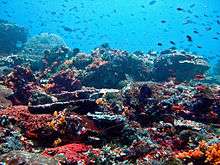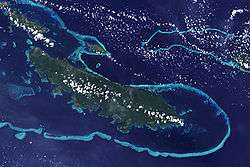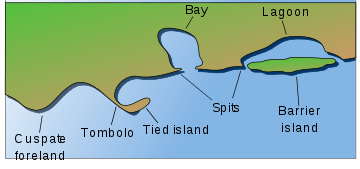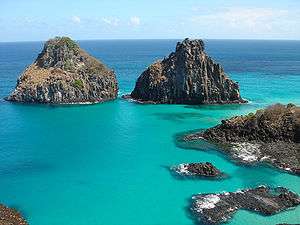Reef
A reef is a shoal of rock, sand, coral or similar material, lying beneath the surface of water. Many reefs result from natural, abiotic processes—deposition of sand, wave erosion planing down rock outcrops, etc.—but the best known reefs are the coral reefs of tropical waters developed through biotic processes dominated by corals and coralline algae.



Artificial reefs (e.g. shipwrecks) sometimes have a role in enhancing the physical complexity of featureless sand bottoms, in order to attract a diverse assemblage of organisms, especially algae and fish.
Earth's largest coral reef system is the Great Barrier Reef in Australia, at a length of over 2,300 kilometres (1,400 miles).
Biotic reef
There is a variety of biotic reef types, including oyster reefs and sponge reefs, but the most massive and widely distributed are tropical coral reefs. Although corals are major contributors to the framework and bulk material comprising a coral reef; the organisms most responsible for reef growth against the constant assault from ocean waves are calcareous algae, especially, although not entirely, coralline algae.
These biotic reef types take on additional names depending upon how the reef lies in relation to the land, if any. Reef types include fringing reefs, barrier reefs, and atolls. A fringing reef is a reef that is attached to an island. A barrier reef forms a calcareous barrier around an island resulting in a lagoon between the shore and the reef. An atoll is a ring reef with no land present. The reef front (ocean side) is a high energy locale whereas the internal lagoon will be at a lower energy with fine grained sediments.
Geologic reef
Geologic reef structures

Ancient reefs buried within stratigraphic sections are of considerable interest to geologists because they provide paleo-environmental information about the location in Earth's history. In addition, reef structures within a sequence of sedimentary rocks provide a discontinuity which may serve as a trap or conduit for fossil fuels or mineralizing fluids to form petroleum or ore deposits.
Corals, including some major extinct groups Rugosa and Tabulata, have been important reef builders through much of the Phanerozoic since the Ordovician Period. However, other organism groups, such as calcifying algae, especially members of the red algae Rhodophyta, and molluscs (especially the rudist bivalves during the Cretaceous Period) have created massive structures at various times. During the Cambrian Period, the conical or tubular skeletons of Archaeocyatha, an extinct group of uncertain affinities (possibly sponges), built reefs. Other groups, such as the Bryozoa have been important interstitial organisms, living between the framework builders. The corals which build reefs today, the Scleractinia, arose after the Permian–Triassic extinction event that wiped out the earlier rugose corals (as well as many other groups), and became increasingly important reef builders throughout the Mesozoic Era. They may have arisen from a rugose coral ancestor. Rugose corals built their skeletons of calcite and have a different symmetry from that of the scleractinian corals, whose skeletons are aragonite. However, there are some unusual examples of well-preserved aragonitic rugose corals in the Late Permian. In addition, calcite has been reported in the initial post-larval calcification in a few scleractinian corals. Nevertheless, scleractinian corals (which arose in the middle Triassic) may have arisen from a non-calcifying ancestor independent of the rugosan corals (which disappeared in the late Permian).
Biotic mound structures
One useful definition distinguishes reefs from mounds as follows: Both are considered to be varieties of organosedimentary buildups – sedimentary features, built by the interaction of organisms and their environment, that have synoptic relief and whose biotic composition differs from that found on and beneath the surrounding sea floor. Reefs are held up by a macroscopic skeletal framework. Coral reefs are an example of this kind. Corals and calcareous algae grow on top of one another and form a three-dimensional framework that is modified in various ways by other organisms and inorganic processes. By contrast, mounds lack a macroscopic skeletal framework. Mounds are built by microorganisms or by organisms that don't grow a skeletal framework. A microbial mound might be built exclusively or primarily by cyanobacteria. Examples of biostromes formed by cyanobacteria occur in the Great Salt Lake in Utah, and in Shark Bay on the coast of Western Australia.
Cyanobacteria do not have skeletons, and individuals are microscopic. Cyanobacteria can encourage the precipitation or accumulation of calcium carbonate to produce distinct sediment bodies in composition that have relief on the seafloor. Cyanobacterial mounds were most abundant before the evolution of shelly macroscopic organisms, but they still exist today; stromatolites are microbial mounds with a laminated internal structure. Bryozoans and crinoids, common contributors to marine sediments during the Mississippian, for instance, produced a very different kind of mound. Bryozoans are small and the skeletons of crinoids disintegrate. However, bryozoan and crinoid meadows can persist over time and produce compositionally distinct bodies of sediment with depositional relief.
The Proterozoic Belt Supergroup contains evidence of possible microbial mat and dome structures similar to stromatolite reef complexes.[1]
See also
- Benjamin Kahn
- Coral reef – Outcrop of rock in the sea formed by the growth and deposit of stony coral skeletons
- Reef Hobbyist Magazine
- Placer (geography)
- Pseudo-atoll – An island that encircles a lagoon, either partially or completely that is not formed by subsidence or coral reefs
References
- Schieber, Jürgen (1998). "Possible indicators of microbial mat deposits in shales and sandstones: Examples from the Mid-Proterozoic Belt Supergroup, Montana, U.S.A." (PDF). Sedimentary Geology. 120 (1–4): 105–124. doi:10.1016/S0037-0738(98)00029-3.
Sources
External links
| The Wikibook Historical Geology has a page on the topic of: Reefs |
| Wikimedia Commons has media related to Reefs. |
- Reef Rescue - Smithsonian Ocean Portal
- Coral Reefs of the Tropics: facts, photos and movies from The Nature Conservancy
- NOAA Photo Library
- Reef Environmental Education Foundation
- NOS Data Explorer - A portal to obtain NOAA National Ocean Service data
- Reef formation
- Atolls – Distribution, Development and Architecture

